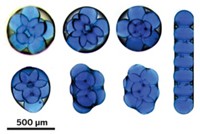Advertisement
Grab your lab coat. Let's get started
Welcome!
Welcome!
Create an account below to get 6 C&EN articles per month, receive newsletters and more - all free.
It seems this is your first time logging in online. Please enter the following information to continue.
As an ACS member you automatically get access to this site. All we need is few more details to create your reading experience.
Not you? Sign in with a different account.
Not you? Sign in with a different account.
ERROR 1
ERROR 1
ERROR 2
ERROR 2
ERROR 2
ERROR 2
ERROR 2
Password and Confirm password must match.
If you have an ACS member number, please enter it here so we can link this account to your membership. (optional)
ERROR 2
ACS values your privacy. By submitting your information, you are gaining access to C&EN and subscribing to our weekly newsletter. We use the information you provide to make your reading experience better, and we will never sell your data to third party members.
Materials
Nanoparticles By Design
Simulations predict wide range of geometries possible via polymer grafting
by Mitch Jacoby
June 26, 2006
| A version of this story appeared in
Volume 84, Issue 26

Nanoparticles tend to come in a limited variety of shapes, such as spheres and rods. A few researchers have succeeded in preparing nanoscale tetrapods and dumbbells. But in general, procedures for preparing nanometer-sized particles that feature exotic shapes and complex structures have not yet been developed.
A new study now suggests that a wide range of nanosized polyhedra may be realizable in the future. The computational investigation predicts that grafting two types of immiscible polymers onto nanoparticles leads to phase separation among the polymer chains. The separation of phases dictates the shapes of the products, which can be tailored by controlling the relative concentrations of the polymers, chain lengths, and other polymer properties (Phys. Rev. Lett. 2006, 96, 248301). The study may lead to new types of functional materials that can be customized on the nanometer scale.
For years, researchers have known that grafting the ends of immiscible polymer chains onto flat surfaces leads to brushlike structures. The loose ends of the chains can adopt a variety of configurations that can be controlled experimentally and thereby form complex surface patterns. That idea has now been extended to spherical surfaces by Jiunn-Ren Roan, a polymer physicist at National Chung Hsing University, Taichung, Taiwan, who developed computational methods to conduct such simulations. The study indicates that phase separation can be exploited to design nanosized octahedra, icosahedra, and other complex shapes.
For example, icosahedral particles are obtained by using a 10-nm-wide particle as the grafting surface and attaching 120 chains of one type of polymer and 60 of another, with each chain measuring 20 repeat units. In contrast, grafting 30 chains each of two types of polymers that differ slightly in the number of repeat units can lead to octahedral products.




Join the conversation
Contact the reporter
Submit a Letter to the Editor for publication
Engage with us on Twitter